The polyoxymethylene market is projected to expand from USD 6.4 billion in 2025 to USD 10.9 billion by 2035, reflecting a compound annual growth rate (CAGR) of 5.5%. The decade-long growth trajectory indicates a steady rise in demand for high-performance engineering plastics that are valued for their mechanical strength, dimensional stability, and chemical resistance. From my perspective, the market is being reinforced by applications in automotive components, consumer electronics, and industrial machinery, where reliability and durability are critical. The 10-year growth comparison demonstrates that polyoxymethylene is being increasingly recognized as a material of choice for precision parts, contributing to operational efficiency and long-term product performance. The gradual but consistent market expansion highlights that production capacities, supply chains, and distribution networks are being optimized to meet the growing industrial requirements.
Over the period from 2025 to 2035, the market is expected to see year-on-year increases, with values rising from USD 6.4 billion to USD 10.9 billion. The growth curve suggests that manufacturers focusing on high-quality resin production, application-specific formulations, and global distribution networks are likely to capture significant market share. The steady CAGR of 5.5% reflects that polyoxymethylene is becoming a standard in precision-engineered components rather than a niche material. Market dynamics are being influenced by factors such as rising industrial automation, demand for lightweight yet durable components, and the replacement of traditional materials with advanced polymers. By 2035, the polyoxymethylene market is expected to be characterized by increased adoption across sectors, reinforcing its position as a critical material in modern manufacturing and assembly processes.

| Metric | Value |
|---|---|
| Polyoxymethylene Market Estimated Value in (2025 E) | USD 6.4 billion |
| Polyoxymethylene Market Forecast Value in (2035 F) | USD 10.9 billion |
| Forecast CAGR (2025 to 2035) | 5.5% |
The polyoxymethylene (POM) market holds a significant share within its parent markets, reflecting its widespread adoption across various industries. In the engineering plastics market, POM accounts for approximately 15–20% of the total market share, driven by its exceptional mechanical properties and dimensional stability. Within the automotive plastics market, POM represents about 30–35%, as it is increasingly utilized in components such as fuel systems, interior parts, and electrical connectors due to its low friction and wear resistance. The electrical & electronics plastics market sees POM comprising around 10–15%, particularly in applications like connectors and switches where precision and durability are paramount. In the medical device plastics market, POM holds a share of approximately 5–10%, owing to its biocompatibility and suitability for components like insulin pens and surgical instruments. The consumer goods plastics market has POM constituting about 5–10%, as it is used in items requiring high strength and low friction, such as zippers and appliance parts. These figures underscore the dominance of POM in specialized applications, driven by its unique properties that meet the demanding requirements of various sectors. Despite challenges such as competition from alternative materials and cost considerations, the market share distribution indicates a clear preference for POM in applications requiring precision, durability, and performance.
The polyoxymethylene (POM) market is witnessing steady expansion, supported by its broad applicability in precision engineering components and its high-performance attributes, including dimensional stability, wear resistance, and mechanical strength. Current growth is underpinned by increasing adoption across automotive, electronics, and industrial machinery segments, where demand is fueled by the need for durable, lightweight, and cost-efficient alternatives to metals.
The supply landscape remains stable due to established production capacities in key manufacturing hubs, though raw material price fluctuations and environmental regulations are influencing cost structures. The future outlook remains positive as advancements in compounding technologies and grade customization are expected to unlock higher-value applications.
Expanding usage in emerging economies, coupled with ongoing industrial automation trends, is projected to sustain market momentum Over the forecast period, strategic integration into high-growth sectors and continuous R&D investments are anticipated to reinforce market resilience and drive consistent revenue growth across global regions.
The polyoxymethylene market is segmented by type, grade, application, and geographic regions. By type, polyoxymethylene market is divided into Copolymer and Homopolymer. In terms of grade, polyoxymethylene market is classified into Standard, Reinforced, Impact modified, Recycled, UV Stabilized, and Special Grade. Based on application, polyoxymethylene market is segmented into Automotive, Consumer Goods, Industrial, Electrical & Electronics, and Other.
Regionally, the polyoxymethylene industry is classified into North America, Latin America, Western Europe, Eastern Europe, Balkan & Baltic Countries, Russia & Belarus, Central Asia, East Asia, South Asia & Pacific, and the Middle East & Africa.
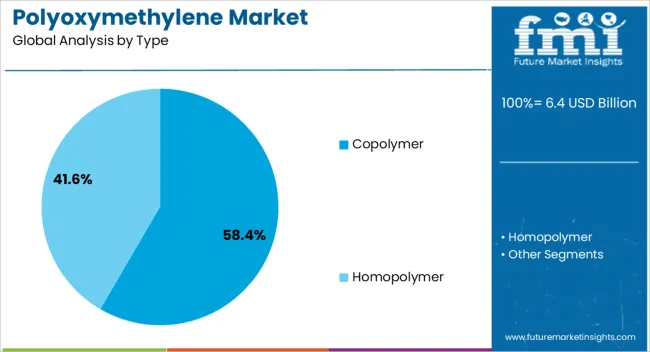
The copolymer segment, accounting for 58.40% of the type category, maintains its leadership position due to superior thermal stability, enhanced chemical resistance, and improved processing flexibility compared to homopolymer variants. Its dominance is reinforced by widespread acceptance in critical applications such as gears, bearings, and automotive structural components, where consistent performance under variable operating conditions is required.
Supply stability is supported by large-scale production capabilities, while manufacturing process improvements have reduced defect rates and improved yield efficiency. The copolymer’s ability to retain mechanical integrity over a broader temperature range has strengthened its suitability for high-demand industrial and transportation environments.
Price competitiveness and adaptability to additive integration for enhanced properties have further entrenched its market position. With growing demand for engineering plastics capable of replacing metals in weight-sensitive designs, the copolymer segment is expected to retain its share advantage through strategic capacity expansions and targeted application development initiatives.
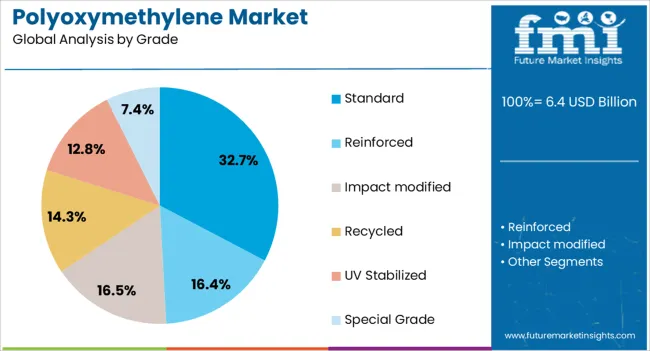
The standard grade segment, holding 32.70% of the grade category, has been sustaining its leading role through its balance of performance, cost-efficiency, and versatility across multiple end-use sectors. This grade is favored for general-purpose applications where consistent mechanical strength, dimensional accuracy, and resistance to wear are essential without necessitating specialized modifications.
Manufacturing scalability and stable raw material sourcing have facilitated competitive pricing, which supports adoption in both developed and emerging markets. The segment benefits from strong penetration in components such as conveyor belts, housings, and connectors, where long service life and cost control are critical procurement criteria.
Its market share is reinforced by the ease of processing and compatibility with standard molding equipment, minimizing production complexities for manufacturers. Future growth is expected to be supported by incremental enhancements in formulation and the development of sustainable production processes, ensuring alignment with evolving environmental compliance requirements.
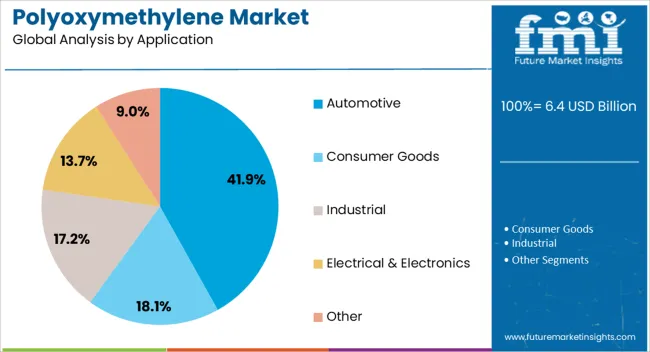
The automotive segment, comprising 41.90% of the application category, leads the market due to the material’s suitability for replacing heavier metal parts in structural and functional vehicle components. Its adoption is driven by stringent fuel efficiency regulations, demand for lightweighting, and the need for components with high wear resistance and dimensional stability under thermal stress.
Applications such as fuel system parts, door handles, and gear housings have contributed significantly to its share dominance. The segment benefits from established supply contracts with OEMs and Tier 1 suppliers, ensuring stable demand pipelines.
Continued growth in electric vehicle manufacturing is anticipated to further enhance adoption, as POM’s insulating properties and mechanical resilience align with EV design requirements. Advances in polymer engineering, enabling higher heat deflection temperatures and improved chemical resistance, are expected to expand its use in critical under-the-hood and structural applications, solidifying the automotive segment’s leadership over the forecast horizon.
The polyoxymethylene market is expanding due to demand from automotive, electronics, and industrial sectors. Opportunities exist in medical devices, industrial automation, and customized formulations. Trends emphasize lightweight, high-performance, and durable polymers, while price fluctuations and environmental regulations pose challenges. Overall, the market is poised for steady growth as manufacturers focus on efficiency, material innovation, and sustainable engineering solutions across multiple industries.
The polyoxymethylene market is witnessing growing demand due to its high mechanical strength, dimensional stability, and low friction properties. Automotive manufacturers are using POM for precision components like gears, bearings, and fuel system parts, while consumer electronics leverage it for connectors, switches, and housing components. The increasing adoption of lightweight, durable, and high-performance plastics in place of metals is driving growth. As industries focus on efficiency, longevity, and cost-effectiveness, POM has emerged as a preferred engineering polymer, reinforcing its steady market demand globally.
Opportunities are emerging as POM finds increasing application in medical devices, machinery, and industrial automation. Its chemical resistance, biocompatibility, and durability make it suitable for surgical instruments, laboratory equipment, and fluid-handling components. Industrial automation systems utilize POM for precision parts, reducing maintenance and enhancing reliability. Growth in emerging economies, coupled with rising investments in healthcare infrastructure and industrial machinery, provides additional avenues for market expansion. Customized formulations catering to specific performance requirements can further strengthen manufacturer competitiveness and capture niche segments.
A key trend in the market is the shift toward lightweight, high-performance, and sustainable engineering polymers. Manufacturers are introducing modified POM grades with enhanced thermal stability, UV resistance, and flame retardancy. POM blends with other polymers are gaining popularity to improve flexibility, toughness, and chemical resistance. Industries increasingly prioritize polymers that reduce component weight without compromising strength. These trends reflect the growing emphasis on efficient, durable, and environmentally conscious material selection, positioning POM as a versatile solution across automotive, electronics, medical, and industrial applications.
The market faces challenges due to price volatility in raw materials and increasing regulatory scrutiny around plastics. Fluctuating costs of methanol and formaldehyde, key POM feedstocks, affect production economics and supply stability. Environmental concerns and restrictions on non-biodegradable polymers pressure manufacturers to explore recycling solutions and eco-friendly alternatives. Additionally, processing complexities and the need for specialized equipment in high-precision applications may limit adoption. Overcoming these challenges requires innovation in cost management, sustainable practices, and advanced production techniques to maintain competitiveness in global markets.
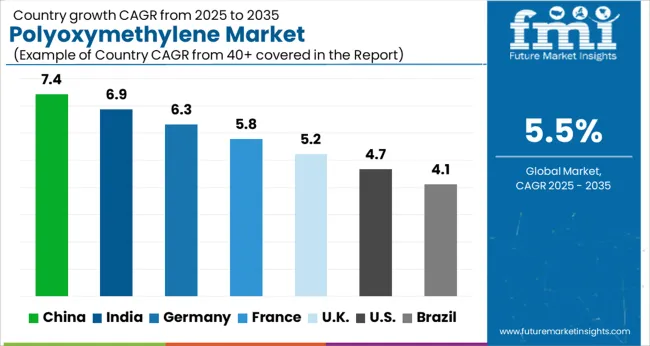
| Country | CAGR |
|---|---|
| China | 7.4% |
| India | 6.9% |
| Germany | 6.3% |
| France | 5.8% |
| UK | 5.2% |
| USA | 4.7% |
| Brazil | 4.1% |
The global polyoxymethylene market is projected to grow at a CAGR of 5.5% from 2025 to 2035. China leads with a growth rate of 7.4%, followed by India at 6.9% and France at 5.8%. The United Kingdom is expected to expand at 5.2%, while the United States shows steady growth at 4.7%. Rising demand for high-performance engineering plastics in automotive, electronics, and consumer goods sectors is driving adoption globally. Emerging markets such as China and India are experiencing rapid industrial expansion, increasing demand for durable components, and strong manufacturing infrastructure. Mature markets like the USA, UK, and France are focusing on product reliability, precision applications, and compliance with regulatory standards. Collectively, these trends highlight the increasing penetration of polyoxymethylene across industries worldwide. This report includes insights on 40+ countries; the top markets are shown here for reference.
The polyoxymethylene market in China is projected to grow at a CAGR of 7.4%, driven by high demand in automotive, electronics, and consumer goods applications. Manufacturers are increasingly adopting polyoxymethylene for precision components, mechanical parts, and electrical assemblies. Industrial automation and expanding manufacturing facilities are supporting increased production and consumption. Domestic production capacity is being enhanced to meet rising demand, while international suppliers are introducing advanced grades of polyoxymethylene. Focus on lightweight, durable, and high-performance plastics aligns with China’s industrial growth strategy. Overall, strong infrastructure, industrial expansion, and growing consumer electronics and automotive sectors position China as the leading market globally.
The polyoxymethylene market in India is expected to grow at a CAGR of 6.9%. The country’s automotive, electronics, and consumer goods sectors are increasingly adopting high-performance plastics for durability and precision applications. Manufacturing expansion and modernization support the integration of polyoxymethylene in mechanical components and electrical assemblies. International collaborations and technology transfers are helping domestic manufacturers meet demand with improved product quality. Consumer demand for reliable and lightweight components in automotive and electronics further drives adoption. India’s industrial infrastructure growth, coupled with increasing focus on efficiency and high-performance materials, positions it as a key emerging market for polyoxymethylene.

The polyoxymethylene market in France is projected to grow at a CAGR of 5.8%. French manufacturers focus on precision engineering applications in automotive, industrial machinery, and electrical equipment. The emphasis on regulatory compliance and product reliability encourages adoption of polyoxymethylene. Technological improvements in polymer processing, molding, and high-performance grades support market growth. Domestic suppliers and international partners provide advanced materials for high-quality components. France’s mature industrial base, coupled with focus on mechanical durability and efficiency, ensures steady demand for polyoxymethylene in multiple sectors.
The polyoxymethylene market in the United Kingdom is forecast to grow at a CAGR of 5.2%. Adoption is driven by automotive, electronics, and consumer product applications requiring precision, durability, and chemical resistance. Manufacturers are leveraging polyoxymethylene for high-performance mechanical parts and electrical components. Supply chain efficiency and technological integration improve production reliability and material utilization. International collaborations and domestic R&D activities enhance product performance and application versatility. While growth is moderate compared to emerging Asian markets, the UK maintains steady demand due to a focus on high-quality, durable materials for industrial and consumer applications.

The polyoxymethylene market in the United States is expected to expand at a CAGR of 4.7%. USA industries, including automotive, electronics, and consumer goods, are increasingly using polyoxymethylene for mechanical components, electrical assemblies, and precision parts. Manufacturers focus on high-performance, lightweight, and durable materials to improve product efficiency. Technological integration and strong supply chain networks support consistent material availability. While growth is slower than in China or India, the USA market remains critical due to large-scale manufacturing, high demand for quality components, and established industrial infrastructure. Adoption continues to be supported by ongoing innovations in polymer grades and processing techniques.
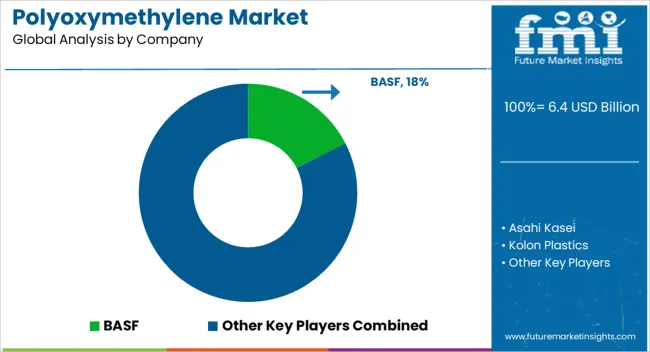
The polyoxymethylene (POM) market is being shaped by global chemical and specialty polymer producers focusing on high-performance engineering plastics for automotive, electronics, and consumer goods applications. BASF leads with its extensive POM portfolio, emphasizing high stiffness, low friction, and excellent dimensional stability. Brochures highlight applications in precision gears, bearings, and connector components, showcasing durability and processing flexibility. Asahi Kasei differentiates through specialty grades that offer enhanced chemical resistance, heat stability, and long-term mechanical performance, targeting automotive and industrial markets. Kolon Plastics focuses on value-added POM solutions for Asian markets, promoting consistent quality, processability, and cost efficiency for mass production components.
These companies are driving the market by emphasizing product reliability, versatility, and compatibility with high-speed molding processes. Marketing materials highlight POM’s benefits in reducing assembly costs, enhancing wear resistance, and supporting lightweight engineering designs. Competition is influenced by the ability to provide tailored polymer grades, technical support, and regional supply stability. Brochures consistently showcase performance advantages, environmental compliance, and the material’s suitability for demanding industrial applications. The market is being positioned as a critical segment of the global engineering plastics landscape, where innovation in polymer formulation and application development drives adoption across multiple sectors.
| Item | Value |
|---|---|
| Quantitative Units | USD 6.4 Billion |
| Type | Copolymer and Homopolymer |
| Grade | Standard, Reinforced, Impact modified, Recycled, UV Stabilized, and Special Grade |
| Application | Automotive, Consumer Goods, Industrial, Electrical & Electronics, and Other |
| Regions Covered | North America, Europe, Asia-Pacific, Latin America, Middle East & Africa |
| Country Covered | United States, Canada, Germany, France, United Kingdom, China, Japan, India, Brazil, South Africa |
| Key Companies Profiled | BASF, Asahi Kasei, and Kolon Plastics |
| Additional Attributes | Dollar sales by grade type (homopolymer, copolymer) and form (granules, rods, sheets, films) are key metrics. Trends include rising demand in automotive, electrical, and consumer goods for high-strength, wear-resistant materials, along with growth in precision engineering applications. Regional adoption, technological advancements, and preference for durable, lightweight polymers are driving market growth. |
The global polyoxymethylene market is estimated to be valued at USD 6.4 billion in 2025.
The market size for the polyoxymethylene market is projected to reach USD 10.9 billion by 2035.
The polyoxymethylene market is expected to grow at a 5.5% CAGR between 2025 and 2035.
The key product types in polyoxymethylene market are copolymer and homopolymer.
In terms of grade, standard segment to command 32.7% share in the polyoxymethylene market in 2025.






Our Research Products

The "Full Research Suite" delivers actionable market intel, deep dives on markets or technologies, so clients act faster, cut risk, and unlock growth.

The Leaderboard benchmarks and ranks top vendors, classifying them as Established Leaders, Leading Challengers, or Disruptors & Challengers.

Locates where complements amplify value and substitutes erode it, forecasting net impact by horizon

We deliver granular, decision-grade intel: market sizing, 5-year forecasts, pricing, adoption, usage, revenue, and operational KPIs—plus competitor tracking, regulation, and value chains—across 60 countries broadly.

Spot the shifts before they hit your P&L. We track inflection points, adoption curves, pricing moves, and ecosystem plays to show where demand is heading, why it is changing, and what to do next across high-growth markets and disruptive tech

Real-time reads of user behavior. We track shifting priorities, perceptions of today’s and next-gen services, and provider experience, then pace how fast tech moves from trial to adoption, blending buyer, consumer, and channel inputs with social signals (#WhySwitch, #UX).

Partner with our analyst team to build a custom report designed around your business priorities. From analysing market trends to assessing competitors or crafting bespoke datasets, we tailor insights to your needs.
Supplier Intelligence
Discovery & Profiling
Capacity & Footprint
Performance & Risk
Compliance & Governance
Commercial Readiness
Who Supplies Whom
Scorecards & Shortlists
Playbooks & Docs
Category Intelligence
Definition & Scope
Demand & Use Cases
Cost Drivers
Market Structure
Supply Chain Map
Trade & Policy
Operating Norms
Deliverables
Buyer Intelligence
Account Basics
Spend & Scope
Procurement Model
Vendor Requirements
Terms & Policies
Entry Strategy
Pain Points & Triggers
Outputs
Pricing Analysis
Benchmarks
Trends
Should-Cost
Indexation
Landed Cost
Commercial Terms
Deliverables
Brand Analysis
Positioning & Value Prop
Share & Presence
Customer Evidence
Go-to-Market
Digital & Reputation
Compliance & Trust
KPIs & Gaps
Outputs
Full Research Suite comprises of:
Market outlook & trends analysis
Interviews & case studies
Strategic recommendations
Vendor profiles & capabilities analysis
5-year forecasts
8 regions and 60+ country-level data splits
Market segment data splits
12 months of continuous data updates
DELIVERED AS:
PDF EXCEL ONLINE

Thank you!
You will receive an email from our Business Development Manager. Please be sure to check your SPAM/JUNK folder too.
Chat With
MaRIA